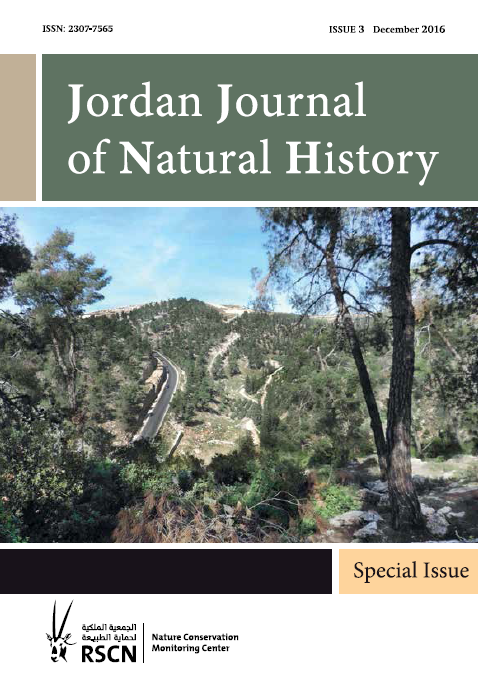Biodiversity Conservation of Wadi Al-Quff Proteccted area (Central Palestine): Challenges and Opportunities
Author Name
Mazin B. Qumsiyeh, Anton Khalilieh, Issa Musa Albaradeiya, and Banan Al-Shaikh
The Occupied Palestinian Territories (OPT) are areas of high but threatened biodiversity. Since the establishment of the Palestinian Authority, there have been increased resources devoted to capacity building and to develop nature protection systems highlighted by the introduction of the Palestinian Environmental Law 1999. One of the mandates of this law is to protect specific areas of high biodiversity and this gained even more importance with Palestine signing the Convention on Biological Diversity (CBD). Wadi Al-Quff (WAQ) region between Tarqumiya and Beit Kahil in the occupied Palestinian territories is an area of special attention as the first Palestinian administered nature reserve and the first one to receive detailed work to generate a management plan. As part of this work we report in these series of papers surveys on the flora and fauna. A significantly rich fauna and flora is noted but is facing a number of threats, with habitat fragmentation and destruction being the most significant. This survey recorded a rich fauna with more than 89 species of birds, 19 species of mammals, 21 reptiles, three amphibians, over 250 identified invertebrates, and over 230 species of plants, despite habitat degradation and limited sampling (time, resource limitations). As a result of our analysis we made four urgent recommendations and six less urgent but highly needed recommendations for biodiversity conservation of WAQ. Urgent recommendations include: 1) Cull/remove feral dogs, 2) Block roads and/or limit access in some areas of WAQ, 3) Discuss with farmers and others stake holders protection measures and limits on activities near or in the park, 4) Prevent fires. The longer-term recommendations are: 1) Monitoring and preventing unlawful activities, 2) Develop sustainable use of some areas, 3) Ameliorate habitat fragmentation and destruction, 4) Work to end the Israeli occupation and empower and educate local people, 5) Address climate change, and 6) Develop an environmental educational center in the protected area
Protected Areas in the Occupied Palestinian Territories
Author Name
Mazin Qumsiyeh and Zuhair Amr
National designation and management of protected areas (PAs) are
critical components in the global effort for biodiversity conservation and environmental protection. In areas of conflict like Palestine, this task becomes more complicated but is even more important considering the environmental challenges posed by colonialism and occupation. Nineteen protected areas were partially or wholly turned over to the Palestinian National Authority and, in 2010, seven others were designated by the Environmental Quality Authority for a total of 26. In 2015, the Palestinian ministerial committee approved a list of 49 protected areas but most of these fall in parts of the Occupied Palestinian Territories (OPT) that are under direct control by the occupying power. In effect only 8 protected areas totaling less than 15 km2 are under Palestinian effective control making management difficult. In this paper we describe the status of protected areas and make a SWOT analysis and recommendations for issues of protected areas in OPT
Flora of Wadi Al-Quff Protected Area, Hebron Governorate, Palestine
Author Name
Banan Al Sheikh and Mohamed Mahassneh
We present data based on a preliminary survey of the flora of the Wadi
Al-Quff Protected Area (WAQPA), Hebron Governorate in the Occupied
Palestinian Territories (OPT). A total of 231 identified species plus ferns were reported through quadrates 20x20m for trees and shrubs and 1x1m for herbaceous plants. Dominant trees and shrubs include Pinus halapensis, Rhamnus palaestina, Quercus calliprinos, Sarcopotrium spinosum, and Cistus creticus. Crataegus aronia, Origanum syriacum, Pistacia lentiscus, and Styrax officinalis are less common in the reserve and need special attention. Twenty three species are rare at OPT level but were found at WAQPA and thus require protection.
Avifaunal baseline assessment of Wadi Al-Quff Protected Area and its Vicinity, Hebron, Palestine
Author Name
Anton Khalilieh
Birds of Wadi Al-Quff protected area (WQPA) were studied during the spring season of 2014. A total of 89 species of birds were recorded. Thirty species were found to breed within the protected area (24 resident and 6 summer breeders), while the others were migratory. Three species of raptors (Long legged Buzzard, Short-toed Eagle and the Hobby) were found to breed within man-made afforested area, nesting on pine and cypress trees. Within the Mediterranean woodland patches, several bird species were found nesting such as Cretzschmar's Bunting, Syrian Woodpecker, Sardinian Warbler and Wren. Thirteen species of migratory soaring birds were recorded passing over WQPA, two of them (Egyptian Vulture and Palled Harrier) are listed by the IUCN as endangered and near threatened, respectively. In addition, several migratory soaring birds were found to use the site as a roosting area, mainly at pine trees.
Fauna of Wadi Al-Quff Protected Area: Amphibians, Reptiles and Mammals
Author Name
Mazin Qumsiyeh
A survey on the vertebrates of Wadi Al-Quff Protected Area (WAQPA) was conducted as part of a management plan preparation. Nineteen mammal species were recorded and all but one (Marbled Polecat, Vormela peregusna listed as vulnerable species) are of “least concern” by the IUCN. The pipistelle bat Pipistrellus pipistrellus was a notable finding as its most southern range of distribution so far in Palestine. Three amphibians were recorded. Among 21 reptile species recorded, three species of geckos were noted including Kotschy's Gecko, Mediodactylys (Cyrtodactylus) kotschyi, representing the southern most record for this species. Other reptiles recorded include the starred agama Stellagama stellio (most common reptile in WAQPA), seven species of lizards, and seven species of snakes. The Spur-thighed Tortoise (Tesudo graeca) and Gunther’s Skink (Chalcides guntheri) are considered vulnerable species according to the IUCN Red List
Invertebrate Fauna of Wadi Al-Quff Protected Area, Palestine
Author Name
Mazin Qumsiyeh
We report results of a preliminary survey of the invertebrate fauna of Wadi Al-Quff area (occupied Palestine). We recorded 23 species of butterflies in 5 families. Moths were a difficult group to classify but we have at least 45 species. Dragon flies and damsel flies were noted in the Wadi Hasaka area. Four mantids in three families, two species of stick insects, one earwig species (Dermeptera) and at least seven species of Orthoptera were noted. There were at least 13 species of Hemiptera (true bugs) and 5 species of Neuroptera (netwing insects). We noted at least 13 species in ten families of the Order Diptera (the flies). We also collected/observed at least 17 species of Hymenoptera in eight families. In the Order Blattoidae (roaches), we noted two species only but the Order Coleoptera (Beetles) was very richly represented with at least 23 species in 10 families. Among parasitic arthropods we collected two species of fleas and three species of ticks (Ixodidae), one of the latter involved in transmittal of spotted fever. Five species of scorpions were noted, the largest being the Jericho or Mt. Nebo scorpion Nebo hierichonticus and the smallest being the brown scorpion Compsubuthus werneri. Two species of pseudoscorpions and two species of camel spiders were collected. A more difficult group was the regular spiders (Araneae) and we noted over two dozen species in at least 8 families. We have some specimens of Collembola and of small spiders that likely represent new taxa. Five Chilopod species (centipedes), one woodlouse (Isopoda), and the very common Syrian Millipede (Order Diplopoda) round the arthropods (joint legged animals). Two species of earthworms were identified but others likely occur. A significant biodiversity of molluscs (snails and one slug) was noted with at least 13 species. While this was a preliminary work on invertebrates and much more remains to be done in alpha level taxonomy, the report adds to the ones in this series identifying fauna and flora and emphasizes the need for implementing the management plan for WAQ nature reserve.




